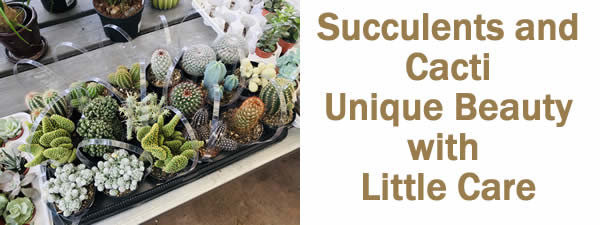
|
Whether they reside in cold zones or in temperate regions, gardeners are incorporating more and more succulents into their gardens and homes. Why are succulents such a growing trend? Succulents can be grown indoors or out, can take full sun to partial shade, are drought tolerant and require little maintenance. Their diverse foliage, in terms of color and texture, provide endless possibilities for incorporation into the garden or when grown in containers. Add to this their beautiful and unusual blooms in a wide array of colors and you have a sure-fire recipe for successful gardening! Succulents flourish in arid climates by storing moisture in their leaves, stems or roots. This ability provides them with their drought-tolerance, allowing them to access water when it is most needed. Succulents that store water in their leaves have plump, fleshy foliage; these leaves can be many different shapes including lance-shaped, paddle, rosette or teardrop. Foliage color can be green, blue-gray, silver or variegated. Succulents that store moisture in their stems tend to have enlarged branches and stems and those that store moisture in their roots have bulbous roots that can be seen at the base of the plant, above the soil line. There is much confusion about differentiating cacti and succulents. How do you know which is which? What are the defining features of each? Because of their ability to store water, all cacti are succulents. But, not all succulents are cacti. Here are a few ways to identify them:
Since most succulents come from warm, dry, frost-free regions, many will not tolerate prolonged wet conditions. There are a few, though, that will thrive in colder, rainier climates such as certain types of Lewisia (those native to the Pacific Northwest), Sempervivum (from europe) and many Sedums. The one common requirement for all succulents is fast-draining soil. A lot of water combined with clay soil is a sure death sentence. Many succulents will thrive in full sun but there are also many varieties that appreciate, or even require, some shade. There are low-growing succulents suitable for use between stepping stones and others that grow large enough (some to 10' or more) to provide a striking focal-point in the garden. If in doubt, be sure to ask us which are preferable for your area; it is safe to say that there is a succulent for (almost) any situation. In mild winter areas, mass plantings of succulents provide a good alternative to more thirsty lawns or flower beds. Succulents can also be attractively paired with drought-tolerant perennials; the succulents will provide great texture with their wide variety of leaf colors and shapes, while the perennials will provide a longer season of flowers. Many succulents make great groundcovers. Just be sure that the area you plant them in will receive no foot traffic; their fleshy leaves and delicate stems are easily crushed and broken. Succulents require little maintenance; occasional removal of spent flower stems and older leaves is usually all that is needed. If grown in the garden, one light feeding at the beginning of the growing season should be enough. Larger and later-blooming kinds, as well as those grown in containers, may benefit from additional fertilizing. Propagating succulents is easy. When taking cuttings from stem-forming types, just let the cut ends form a callus, then stick them right in a well-drained soil. They will root and take off right away. Some types of succulents (agave, aloe, sempervivum) form offsets around the parent plant. These offsets can be removed and replanted. Succulents are a diverse group of plants that will help you add unique form, texture and foliage color to your garden without much care of maintenance--what a deal! |